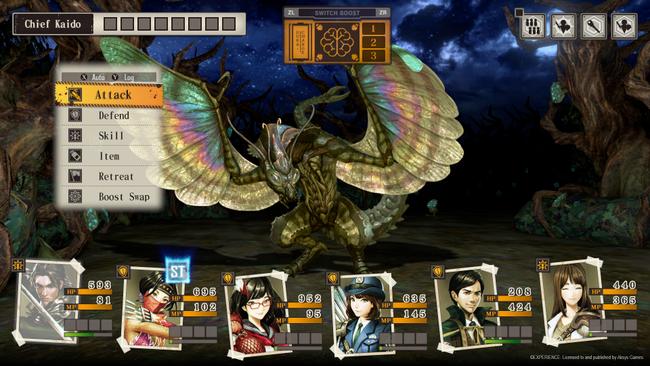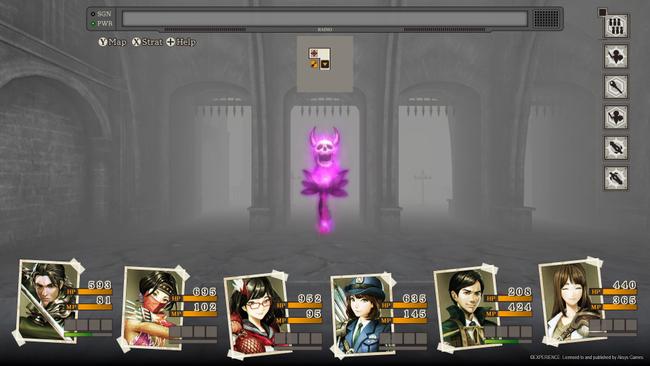
Undernauts: Labyrinth of Yomi Review
Nothing is more frustrating, as a reviewer, than playing a game that by all accounts could find itself much improved by just a number of small tweaks. The gameplay itself is solid, the level design inspired, and the story, art direction, and soundtrack all hit the mark alongside the game’s integral mechanics. But, we’ve all been there – when all of the “small” issues with a game add up to drag it down. Undernauts: Labyrinth of Yomi is an excellent example of this, offering a great DRPG that I can easily recommend to fans of the genre, but myriad issues – such as a lack of Quality-of-life features, and frustrating pace-breakers – just barely prevent me from extending that recommendation to everyone new to the genre as well. At least, not without a light warning.
Let’s start with what the game gets right. From the moment you start the game, it’s apparent that Undernauts has a striking aesthetic. Experience Inc. has released several games using the same general visual design under the Spirit Hunter brand in recent years, but this hand-drawn, watercolor art style first saw its use in Stranger of Sword City. I could go on and on about how gorgeous it looks; how party members’ portraits radiate character, or how the enemy designs navigate the feeling between cute and unsettling, depending on the context you find yourself in. When you’re playing a Dungeon Crawler, it’s imperative that the enemies that you face are memorable – and Undernauts passes that test with flying colors. I never thought a cross between a beetle and a frog could make a compelling monster design; nor did I have the deviation to envision a skeleton where all the bones are replaced with the hard carapace of a demented bug. It’s plain to see that Experience’s, err, experience with Horror games have translated well to designing monsters that set a tone for Undernauts.

Music has also been a strong suit for the company in the past – Stranger of Sword City’s vocaloid-infused soundtrack was rather unique as RPGs go, and while Undernauts lacks that particular quirk to its music, it still pairs well with the Retro-Neo Tokyo vibe of the art style. “Namennayo!” is a J-Pop throwback and whenever it popped up on the radio back at camp, I couldn’t help but feel pumped up. It’s harder to point to any other specific songs, mostly due to it being rather hard to actually find uploads for the soundtrack online, along with Experience having yet to release the soundtrack themselves. Still, it sets the tone more than well enough, even when having nothing but ambient noise would be best.
Aesthetic is all well and good, but a DRPG is only as good as its party-building, combat, and dungeon design. This is where it becomes easier to recommend Undernauts to players new to the genre. While some of Experience’s older works featured some brutal difficulty spikes and required obsessive planning when it came to party composition – Undernauts offers a much more forgiving experience. There is no permadeath. Almost anything about your characters' stats can be changed at will; character class, skill points, and bonus stats are all free to be reset at no cost to players, whenever they wish. There’s still a decent amount of customization available for players to play with, but unlike Stranger of Sword City, you’re not going to be forced to reset a unit’s level so that they can inherit skills from one class to another. It strikes a decent enough balance, and while I did somewhat miss the complexity from other games in the genre – between bonus points, equipment, and allocating skill points, you still have to actively consider the party that you want to build. It’s just that this time you’re never outright punished for making the wrong decisions at first; you’re always given the opportunity to go back to the drawing board without the need for hours of grinding.

Combat is where Undernaut probably shines brightest, all thanks to the “Boost” system. At the start of every battle, players have access to three “Boosts” that they can activate: Overcharge, which reduces the MP cost of skills to 0 while boosting their effectiveness. Duracharge, which halves damage taken by the party for the turn, while restoring a portion of HP at the turn’s conclusion. Finally, Neurocharge; which lets all of your party members move before any enemies in the fight, with the added benefit of increasing the number of rewards at the end of an encounter, if you can time finishing the battle the same turn you activate it. Each of these 3 Boosts must be recharged before they can be used again, but you can only begin to replenish them whenever a turn passes where no Boosts are active. Adding another wrinkle to matters, there’s a pattern for which Boost will replenish first – so there’s a juggling aspect to it all, planning several turns ahead so you can maximize the effectiveness of your strategy.
In practice, it’s a lot of fun and makes combat feel very dynamic – while at the same time, it’s a very easy mechanic to understand within a short period of time. Combined with the streamlined party-building, it makes Undernauts a very “comfortable” DRPG to play, and get into. It manages to strike a good balance between feeling very easy to pick up and play while maintaining just enough complexity to keep everything engaging. If you’ve played any of Experience’s other works you’ll certainly notice how things have been simplified, but it’s not like the fat has been trimmed to such a degree that it has an impact on what makes their DRPGs engaging in the first place. If anything, based on the merits of the combat alone, it would be very easy to recommend Undernauts to someone looking to get into the genre.

Dungeon designs continue this trend of maintaining enough complexity to remain engaging, while genuinely feeling like they have the best level design that the company has put out to date. Taking what feels to be a page from Nippon-Ichi Software’s approach with Labyrinth of Refrain, players have the ability to modify specific portions of the dungeon by using special “Flowers” that can be crafted back at base. These can range from doors that breach walls, ladders to ascend or descend floors, a healing point that will disable damage tiles on whatever floor that they’re placed in, and more. Even if the dungeons themselves are predominantly linear – the addition of these Flowers helps make progression feel much more open-ended than it usually is. Beyond that, by having specific dungeons themed around specific usages of the Flowers, each location ends up feeling that much more unique in the long run. Augmenting this is the side activity of searching for Cup Noodles in each of the dungeons, that you can turn in at camp for charming world-building.
Unfortunately, later dungeons showcase how the system can also have dire consequences for pacing. The further along in the story, dungeons will ask for more and more flowers in order to progress – which means spending more time heading back to base, breaking down materials for FP (Flower Points, naturally), and then returning to the location where you left off. This wouldn’t be so bad if players could easily return to wherever they left off easily – the problem is that your access to Portal Flowers that allow you to teleport from your home base to a given location is limited throughout the story, and that means that inevitably there will be times where you’ll have to make the trek manually. Undernauts’ dungeons are interconnected, to a degree – and it’s legitimately cool when you can find a Portal Flower to move from one dungeon to another – but when you undersell how many Flowers you’ll need to progress, it can get stale fast.

Similarly, while there are sorting options for the equipment and items that drop from specific enemy encounters, actually comparing and contrasting equipment to determine which is stronger is a futile affair unless at least one of the items in question is currently equipped by a party member. Even then, the sorting options that do exist within the game are woefully inadequate for determining which items you want to keep and which you’ll want to break down for either currency or FP. While managing your parties’ stats is well and easy, managing their equipment is another story entirely. The same goes for the rest of your inventory as well – including Flowers.
Simply making sure you have enough of the right Flowers to progress in a dungeon is one thing, the variety of flowers that you have in your possession can get a bit out of hand by the time you’re reaching the end of the story. This wouldn’t be a problem if the game prompted you to use a flower whenever you bumped into a wall, or pit, or brought up the Flower menu whenever you were on top of – or below – a point to place a Ladder. There is only 1 type of Flower that you would, or even could, use in those situations. Instead, the game forces you to manually open the Flower menu, and manually select the Flower that is necessary for each situation. This is innocuous enough early on, but even as early as entering one of the game’s Treasure Dungeons, wherein you’re tasked with slowly carving out a path through dozens of walls? It becomes frustrating that every single time you’ll be forced to stop and select a Door Flower, or a Ladder Flower, manually. There must’ve been a better way to handle this.
Maybe I’m blowing this out of proportion. Perhaps it’s a bit of a nitpick – it certainly doesn’t erase everything that the game does so well. I’d still give Undernauts a hearty recommendation to anyone already familiar with the genre, and I’d likely do the same for anyone looking to get into DRPGs as a whole. In the end, it didn’t hamper my enjoyment of the game much at all; it’s just incredibly frustrating that problems that feel like they should be easy enough to fix are holding back what would otherwise be the perfect game to introduce players to my favorite genre of RPGs. It still more than earns my recommendation, I just hope that Experience can polish out these few remaining rough edges down the line.